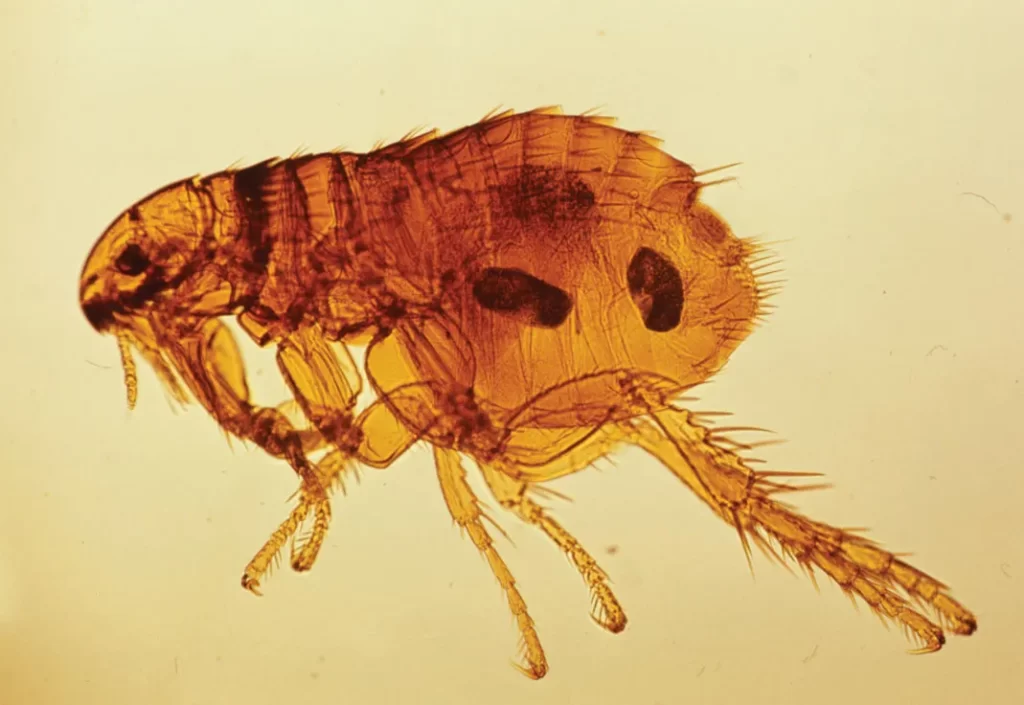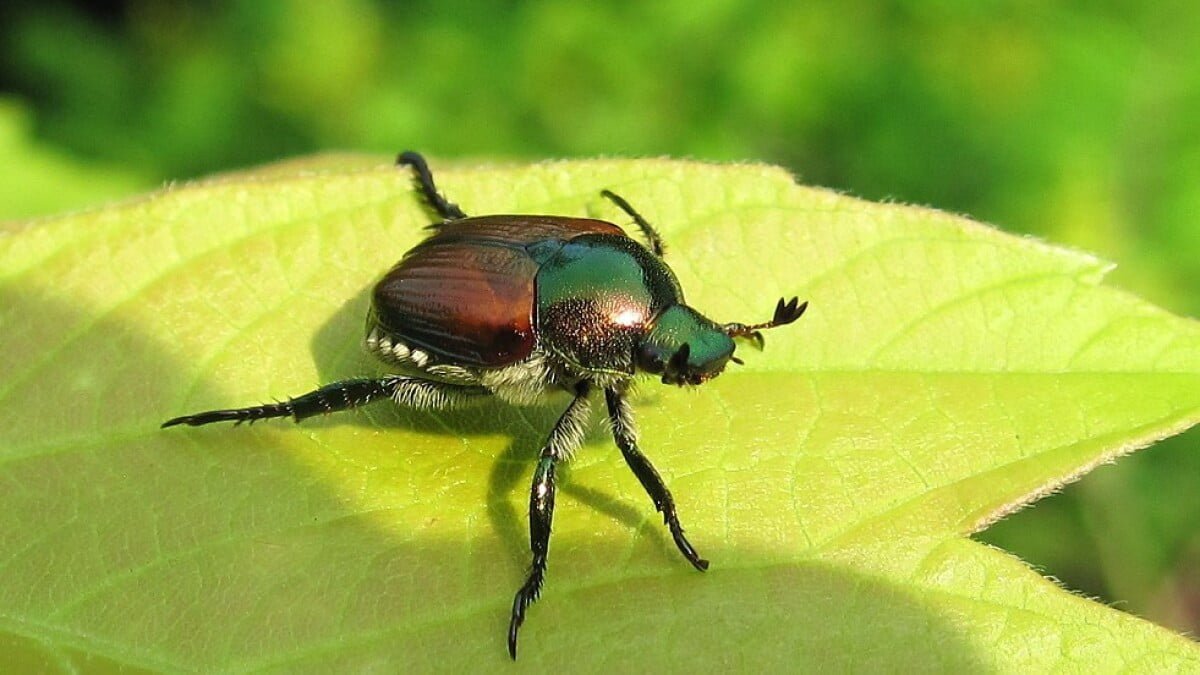Flea insect Facts, FAQs, Behaviour, Habitat, Conservation and more

Flea insect Facts | Description | Distribution and Habitat | Conservation | Behaviour and Ecology | Interaction with Human | Cultural | Interesting facts | frequently asked questions about Flea
Fleas, the tiny wingless insects known for their jumping abilities, have been a nuisance to humans and animals for centuries. These bloodsucking parasites are commonly found on household pets, wildlife, and even humans. Fleas are known to cause intense itching, irritation, and in some cases, transmit diseases.
Their small size and fast reproductive rate make them challenging to eradicate once they infest a space. Fleas thrive in warm and humid environments, making them most prevalent during the summer months.
Despite their reputation as a pest, fleas have unique adaptations that make them fascinating creatures. From their powerful legs to their specialized mouthparts, fleas are designed for survival. Whether you’re studying biology or dealing with a flea infestation, understanding these remarkable insects can provide valuable insights. In this article, we’ll dive deeper into the world of fleas and explore their behavior, life cycle, and ways to control their population.
Taxonomy of Flea
| Kingdom | Animalia |
|---|---|
| Phylum | Arthropoda |
| Class | Insecta |
| Order | Siphonaptera |
| Suborder | Pulicomorpha |
| Superfamily | Pulicoidea |
| Family | Pulicidae |
Morphology of Flea
| Body Part | Description |
|---|---|
| Head | Small, round, and flattened |
| Antennae | Short and bristle-like |
| Eyes | Reduced, often absent |
| Mouthparts | Specially adapted for piercing and sucking blood |
| Thorax | Broad and flattened, with strong legs for jumping |
| Legs | Long and powerful, adapted for jumping |
| Abdomen | Elongated, with bristles and spines |
| Wings | Absent |

Description of Flea
Fleas are tiny, wingless insects that belong to the order Siphonaptera. These parasites are known for their ability to jump long distances, making them difficult to catch or kill. They are commonly found on household pets, wildlife, and even humans.
Fleas have a flattened, reddish-brown body that ranges from 1-3mm in length. They have a small, round head with short antennae and reduced or absent eyes. Their mouthparts are specialized for piercing the skin and sucking blood, with sharp mandibles and a long proboscis for feeding.
The flea’s thorax is broad and flattened, with strong legs adapted for jumping. Their hind legs are particularly long and powerful, allowing them to jump up to 200 times their body length. The abdomen is elongated and has bristles and spines to help them cling onto their host.
Fleas do not have wings, but their flattened bodies allow them to move quickly through the fur or feathers of their host. They feed on the blood of their host, causing intense itching, irritation, and in some cases, transmitting diseases.
Fleas reproduce rapidly, with females laying up to 50 eggs per day. These eggs hatch into larvae, which feed on organic debris and the feces of adult fleas. After several molts, the larvae spin cocoons and enter the pupal stage, from which they emerge as adult fleas.
To control flea populations, it is essential to treat both the host and the environment. This can include the use of insecticides, flea collars, and regular grooming and cleaning of pets and their living areas.
Overall, fleas are a fascinating yet troublesome insect that has adapted well to their parasitic lifestyle. Their unique morphology and jumping ability make them challenging to eradicate, but with proper treatment and prevention, flea infestations can be controlled.
Distribution and habitat of Flea
Fleas are a globally distributed insect, found in a variety of habitats. They are most commonly associated with domestic animals and wildlife, but they can also infest humans and other mammals, including rodents and birds.
Fleas are prevalent in warm and humid environments, making them most common during the summer months. They are also found in areas with high humidity, such as coastal regions and tropical rainforests. However, fleas are adaptable and can survive in a range of environments, including deserts and arctic tundras.
Fleas are typically found in the host’s fur or feathers, as well as their living environment. This includes carpeting, furniture, bedding, and outdoor areas where the host animal may spend time. Flea populations can quickly become widespread, as they reproduce rapidly and can move from host to host.
In addition to their natural distribution, fleas have been introduced to new areas through human activity. For example, the rat flea (Xenopsylla cheopis) is responsible for transmitting the bubonic plague and was introduced to the Americas during the 16th century through trade and migration.
Overall, fleas have a broad distribution and can be found in a range of habitats. They are most commonly associated with domestic animals and wildlife, but can also infest humans and other mammals. Flea populations can quickly become widespread, making prevention and treatment essential for controlling infestations.
Behaviour and Ecology of Flea
Fleas are highly adapted to their parasitic lifestyle, with unique behaviours and ecology that enable them to survive and thrive. Here are some notes on the behaviour and ecology of fleas:
- Bloodsucking Behaviour: Fleas are obligate bloodsuckers, meaning they require a blood meal to survive and reproduce. They use their specialized mouthparts to pierce the skin of their host and suck blood, which can cause irritation, itching, and in some cases, transmit diseases.
- Jumping Ability: Fleas are known for their incredible jumping ability, which allows them to move quickly between hosts and avoid detection. They can jump up to 200 times their body length, thanks to powerful legs and a unique joint structure that stores and releases energy.
- Reproduction: Fleas reproduce rapidly, with females laying up to 50 eggs per day. These eggs hatch into larvae, which feed on organic debris and the feces of adult fleas. After several molts, the larvae spin cocoons and enter the pupal stage, from which they emerge as adult fleas.
- Host Range: Fleas have a wide host range, including domestic animals, wildlife, and even humans. They are often associated with specific hosts, such as the cat flea (Ctenocephalides felis) and dog flea (Ctenocephalides canis), but can infest a range of mammals, including rodents and birds.
- Environmental Adaptation: Fleas are adaptable to a range of environments, from deserts to arctic tundras, but are most common in warm and humid environments. They are often found in the host’s living environment, such as carpeting, furniture, and bedding.
- Disease Transmission: Fleas are known to transmit a range of diseases to humans and animals, including bubonic plague, murine typhus, and tapeworms. They can also cause severe itching and irritation, which can lead to secondary infections.
Overall, fleas have a unique behaviour and ecology that enables them to thrive as bloodsucking parasites. Their jumping ability, wide host range, and rapid reproduction make them a challenging pest to control. Prevention and treatment are essential for controlling flea infestations and reducing the risk of disease transmission.
Conservation of Flea
Conservation or cultivation of fleas is not typically a concern, as they are widely considered to be pests and are often actively controlled through pest management measures. However, there are a few potential avenues for conservation or cultivation of fleas that are worth discussing.
- Use as a Food Source: While not commonly consumed in Western cultures, fleas are eaten in some parts of the world as a source of protein. Insects are increasingly being explored as a sustainable and environmentally friendly food source, and fleas could potentially be cultivated for this purpose.
- Use in Medical Research: Fleas are used in medical research to study blood-feeding behaviour, disease transmission, and other aspects of parasitology. Their unique biology and behaviour make them an ideal model organism for studying these topics.
- Protection of Host Species: While fleas themselves are not typically considered a species of conservation concern, protecting the host species they infest could indirectly benefit flea populations. For example, conservation efforts aimed at protecting endangered wildlife species that are hosts for fleas could help preserve flea populations as well.
Overall, conservation or cultivation of fleas is not typically a priority, as they are widely considered to be pests. However, there are some potential uses for fleas in areas such as food production and medical research, and protecting host species could indirectly benefit flea populations.
Interaction with Human of Flea
Fleas can have a significant interaction with humans, as they are known to bite and cause irritation and itching. Flea bites can lead to a range of symptoms, including redness, swelling, and in some cases, an allergic reaction. In addition to their direct impact on human health, fleas can also transmit diseases such as bubonic plague, murine typhus, and tapeworms.
Humans can come into contact with fleas in a variety of ways. If pets or other animals are infested with fleas, humans can become accidental hosts and may experience flea bites. Additionally, fleas can be brought into the home on clothing or other items and can quickly establish infestations in carpets, bedding, and furniture.
To prevent flea bites and infestations, it is important to take steps to control fleas in the environment. This may include regular vacuuming, washing bedding and clothing in hot water, and using flea control products on pets. If a flea infestation is suspected, professional pest control services may be needed to effectively eliminate the problem.
Overall, fleas can have a significant interaction with humans, as they can cause bites and transmit diseases. Preventing and controlling flea infestations is essential for protecting human health and reducing the risk of disease transmission.
Cultural and Historical Significance of Flea
Fleas do not have significant cultural or historical significance in most cultures. However, there are a few examples of fleas playing a role in folklore and mythology in some cultures.
- Norse Mythology: In Norse mythology, the goddess Freyja is said to ride a chariot pulled by two cats that are able to transform into lions. These cats were said to be infested with fleas, which were believed to be a symbol of the goddess’s power and strength.
- Chinese Folklore: In Chinese folklore, fleas are sometimes associated with the goddess of fertility and childbirth. It was believed that if a woman wished to conceive a child, she could capture a flea and release it into a dish of rice. If the flea jumped, it was said to be a sign that the woman would become pregnant.
- Medieval Europe: During the medieval period in Europe, fleas were associated with the Black Death, a devastating epidemic that killed millions of people. The fleas that infested rats were responsible for transmitting the disease, and their presence was seen as a sign of impending doom and divine punishment.
Overall, fleas do not have significant cultural or historical significance in most cultures. However, there are a few examples of fleas playing a symbolic or mythological role in some cultures, and their association with the Black Death has had a lasting impact on Western culture.
Explanatory Notes for Flea
Here are a few explanatory notes related to fleas:
- Fleas are ectoparasites: Fleas are external parasites that live on the skin of their hosts, rather than living inside their bodies.
- Fleas have flattened bodies: Fleas have flattened bodies that allow them to move easily between the hairs or feathers of their hosts.
- Fleas are known for their jumping ability: Fleas are able to jump up to 7 inches in the air, which allows them to move quickly and easily from host to host.
- Fleas can survive for long periods of time without feeding: Adult fleas can survive for several months without feeding, which allows them to remain dormant in the environment until a suitable host is available.
- Flea infestations can be difficult to control: Flea infestations can be difficult to control because fleas can lay hundreds of eggs at a time, and the eggs can remain dormant in the environment for months before hatching.
By providing these explanatory notes, readers can gain a better understanding of some of the unique characteristics and behaviours of fleas, as well as some of the challenges associated with controlling and preventing flea infestations.
Interesting facts about Flea
- Fleas are one of the most common ectoparasites, with over 2,000 known species.
- Fleas have been around for millions of years and are believed to have evolved from a type of fly.
- The female flea can lay up to 50 eggs per day, which can quickly lead to a flea infestation.
- Fleas are able to jump up to 150 times their own body length, which is one of the highest jumping abilities of any animal.
- Fleas are attracted to warmth, carbon dioxide, and movement, which is why they tend to bite humans and other animals in areas such as the ankles and legs.
- Fleas are able to survive for long periods of time without feeding, which allows them to remain dormant in the environment until a suitable host is available.
- Fleas are known to transmit diseases such as bubonic plague, murine typhus, and tapeworms.
- Some species of flea, such as the oriental rat flea, are responsible for spreading deadly diseases throughout history, including the Black Death.
- Fleas have a hard outer shell that allows them to resist being crushed by human fingernails.
- Fleas have a unique mouthpart that is adapted for piercing the skin of their host and sucking blood, which can cause irritation and discomfort.
General queries or frequently asked questions about Flea
What are fleas?
Fleas are small, wingless insects that live as external parasites on the skin of mammals and birds.
What do fleas look like?
Fleas are typically reddish-brown in color and have flattened bodies that allow them to move easily between the hairs or feathers of their hosts.
How do fleas move from host to host?
Fleas are able to jump up to 150 times their own body length, which allows them to easily move from host to host.
What kind of diseases can fleas transmit?
Fleas are known to transmit diseases such as bubonic plague, murine typhus, and tapeworms.
How can I prevent a flea infestation in my home?
Preventing a flea infestation can be done by regularly vacuuming carpets and furniture, washing pet bedding and toys, and using flea prevention products on pets.
How do I know if my pet has fleas?
Symptoms of a flea infestation in pets include scratching, biting, and licking, as well as the presence of flea dirt (feces) in their fur.
Can fleas live on humans?
While fleas prefer to live on animals, they can also infest humans and bite them for blood.
What are some natural remedies for getting rid of fleas?
Natural remedies for getting rid of fleas include using diatomaceous earth, vinegar, or essential oils such as lavender or eucalyptus.
Do flea bites itch?
Yes, flea bites can cause itching and discomfort for both humans and animals.
Are flea infestations dangerous?
While flea infestations are not typically dangerous, they can cause irritation, discomfort, and the transmission of diseases.
Conclusion
In conclusion, fleas are small but fascinating insects that have a significant impact on both humans and animals. They are known to transmit diseases and can cause irritation and discomfort to their hosts. Fleas have a unique morphology and behavior that allows them to survive and thrive in a variety of environments. Prevention and treatment of flea infestations can be done through a combination of regular cleaning, flea prevention products, and natural remedies. While fleas may not be the most popular of insects, they are certainly interesting and worthy of study.












